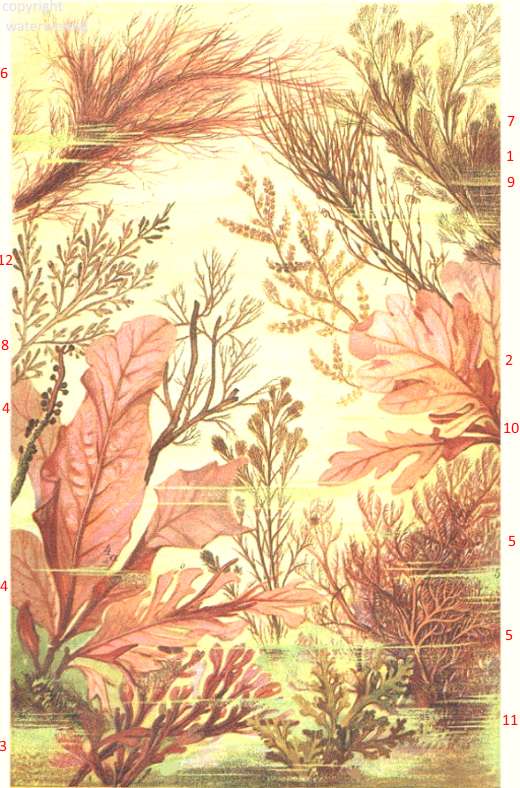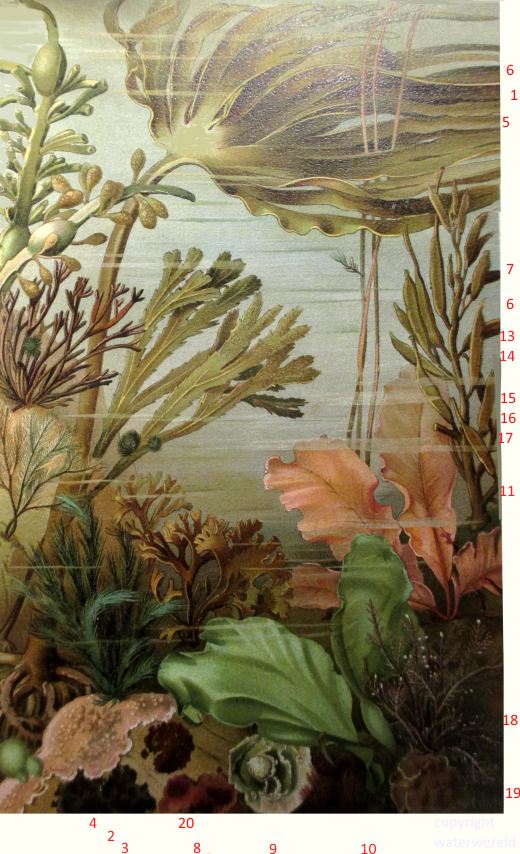sea beech or Delleseria sanguinea
Sea Beech is a red seaweed that grows in the intertidial zone on rocky shores. It can be found on all the rocky coasts of the east Atlantic and North sea coasts. The color is crimson, which makes it easy to distinghuise from other seaweeds. The sea beech loose it blades in the spring, only the midrib remains.

Red seaweed from the north sea and Atlantic ocean, an illustration made by Kuckuck.
1 Cystoclonium purpurascens
2 Phycodrys rubens
3 Delesseria alata.
4 Sea Beech or delesseria sanguinea
5 Plocamium cartilagineum
6 Polysiphonia stricta
7 Polysiphonia nigrescens
8 Lobster Horns or Polysiphonia elongata
9 Brongniartella byssoides
10 Rhodomela subfusca,
11 Pepper Dulse or Laurencia pinnatifida
12 Chondria dasyphylla.
sea beech morphology
Sea beech has a short stalk, 1 cm long, and has a thick hold fast.
n farmacology The oval blades have a prominent midrib. On this rib some small elevations can be seen: these are reproductive structures called cytocarps. The female plant is fertilized in the autumm, and the (carpo)spore are released in the spring:

Seaweed around Helgoland, Northsea.
source: "Die Pflanzenwelt", dr Otto Warburg, 1903.
1 oarweed or Laminaria digitata
2 Lithothamnium Calcareum
3 Pseudolithoderma extensum
4 Tufted Sea Moss or Cladophora rupestris
5 rockweed, Norwegian kelp, knotted kelp or Ascophyllum nodosum
6 dead man's rope or sea lace or chorda filum
7 ectocarpus attached to the sea lace
8 Hildenbrandia rubra
9 Porphyra umbilicalis (this is the Conchocelis rosea, the diploid stage)
10 sea lettuce or ulva lactuca
11 Chaetopteris plumosa
12 Polyides lumbricalis var. fastigiatus
13 cladophora lanosa
14 Acrosiphonia arcta attached on cladophora lanosa
15 toothed wrack or serrated wrack or fucus serratus
16 Elachista fucicula attached on fucus serratus
17 Sea Beech or delesseria sanguinea
18 coral weed or corallina officinalis
19 Lithophyllum incrustans
20 Irish moss or carrageen moss or chondrus crispus
sea beech in farmacology
Delesseria sanguinea has been researched as an alternative to heparin:
Patients with cancer have an increased risk of venous thromboembolic complications (Smorenburg et al., 1999b).
Consequently, numerous cancer patients are treated with anticoagulants, including heparins, to reduce the risk of (recurrent) thrombosis. Interestingly, the results of these trials have also indicated that treatment with heparins may affect survival of patients with malignancy. Delesseria sanguinea has only a small anticoagulant effect, but seems to be much more interresting as an seaweed that has also effects of spreading cancer in the body (this is called: metastasis).